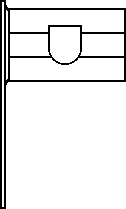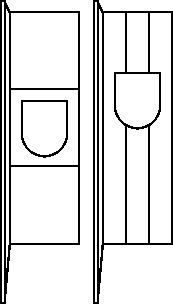Austria: Vertical Hoisting of Flags (original) (raw)

This page is part of © FOTW Flags Of The World website
Last modified: 2025-11-01 by martin karner
Keywords: [hanging flag](keywordh.html#hanging flag) | vertical | [flapping flag](keywordf.html#flapping flag) | haengeflagge | banner | knatterflagge | hissflagge | [triangelfahne](keyword
.html#
triangelfahne) | haengefahne | knatterfahne |
Links: FOTW homepage |search | disclaimer and copyright | write us | mirrors
See also:
Vertical Hoisting
 ratio variable, commonly around 3:10~, by Željko Heimer
[Click for larger view.]
ratio variable, commonly around 3:10~, by Željko Heimer
[Click for larger view.]
The ratio of the vertical flag is not prescribed (but shown in an accompanying drawing in Album des Pavillons 2000 as close to 3:10~). It is prescribed always to be hoisted from a crossbar, and it is forbidden for the vertical flag to include the coat of arms (though, I could swear I have seen them in use).
Željko Heimer, 20 February 2001
One of the biggest problems for vexillologists in Austria is the widespread use of the so-called Hausfahnen or Hängefahnen. Their ratio not being prescribed, they come in all lengths – up to 20 meters suspended from rooftops. This tradition goes back centuries, the advantage being of course that in land-locked, no-navy Austria there are times without wind in which vertical flags "do show" while horizontal flags do not unfurl.
Since the state flag was regulated in 1984, the vertical flag with an eagle is slowly going out of use, being discouraged by flagmakers.
Peter Diem, 16 August 2002
Note that vertically hanging flags are part of the Central European tradition, of which Austria is the core, and it would be all but logical that these flags would be then used everywhere else around but in Austria. Vertical flags are in frequent use in Bavaria,Slovenia, Hungary, Slovakia etc. As Peter Diem says, the tradition goes back centuries, and should not be shunned. And, it should not be a problem for vexillologists. They should (as we should on FOTW) note the usage and practice, compare it with legislation etc. Slovenian local flags deal with this problem properly, providing legislative basis for this custom that is certainly backed with the weather conditions and wish for the best, most useful and most decorative flag display.
Željko Heimer, 20 August 2002
Forms of hoisting flags in Germany, Austria and adjacent countries
| Hissflagge (a.k.a. Flagge, Hissfahne, Querflagge, Querfahne, horizontale Hissflagge, horizontale Hissfahne) | |
|---|---|
 |
The Hissflagge (often simply called "Flagge") is the "normal" form known from most countries. It is a flag hoisted on a vertical flagpole. The Hissflagge is wider than high (in Germany and Austria usually 2:3 or 3:5). Stripes of German flags are usually arranged from top to bottom (e.g. black-red-gold). A coat-of-arms is usually displayed in the centre (often slightly shifted to the hoist).In many parts of Germany (especially in the inland states) and in Austria this type of flag would not be considered as the "normal" or "default" type of a flag by most of the people. In Bavaria, for instance, most of themunicipal flags are used as a Banner or Hängeflagge or Knatterflagge. Also the federal flag or the Bavarian flag are more frequently used in a vertical format, even by the Bavarian ministries. |
Sources: [z2h90], [jtn96], [die95]
Websites of flagmakers and flagsellers with information on the different forms:
http://www.bofa.de/arten.html
http://www.flaggen.de/Pages/sond_anf.htm
http://www.fahnen-koessinger.de
http://www.fahnen-gruber.de
http://www.fahnen-fuchs.de
http://www.fahnenfabrik.at/11.htm
http://www.fahnen-gaertner.com/produkte.html
http://www.montfortfahnen.at/Produkte/Fahnen/fahnen.html
M. Schmöger, 26 October 2001/19 August 2003


